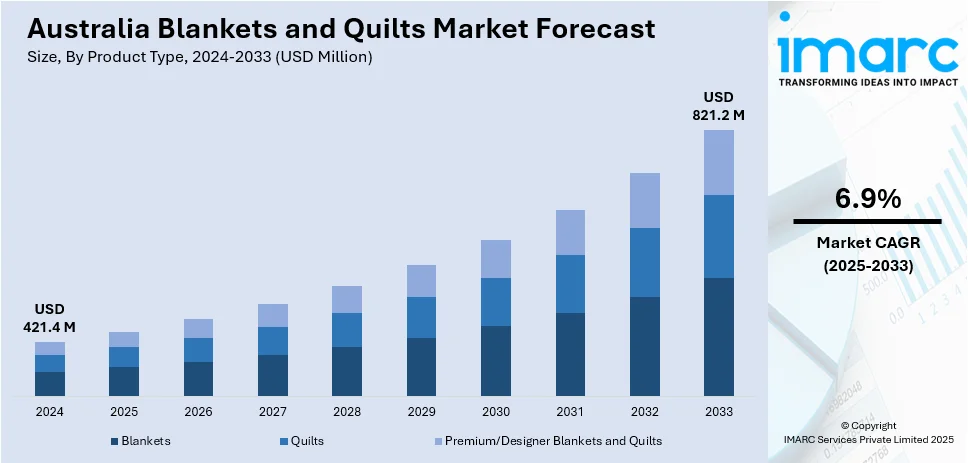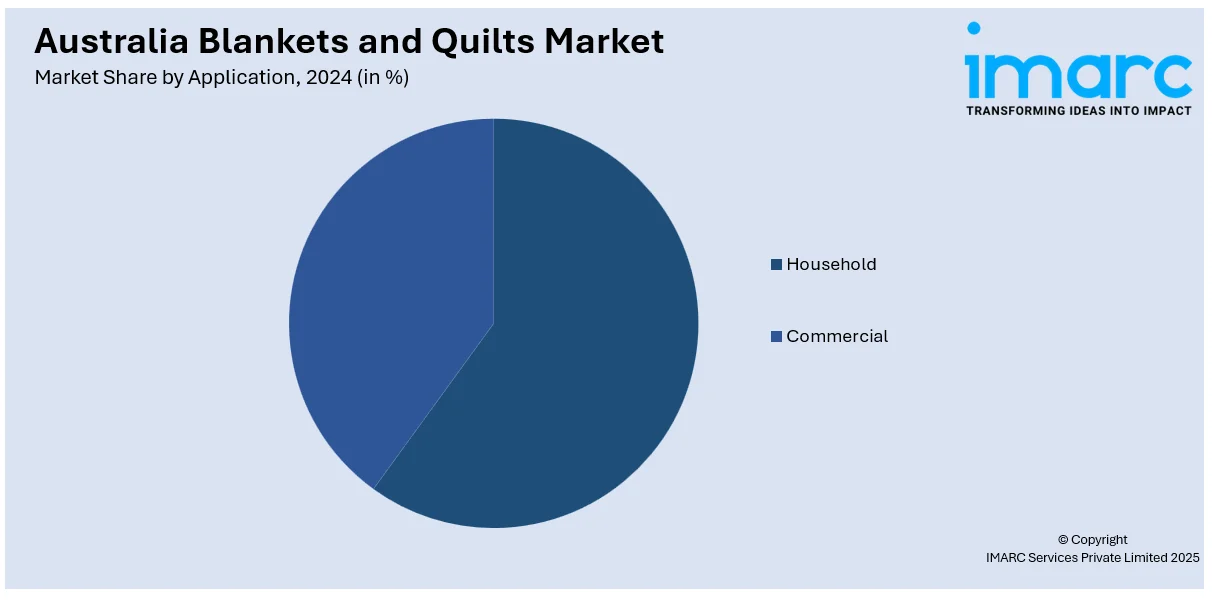
Australia Blankets and Quilts Market Size, Share, Trends and Forecast by Product Type, Material, Application, Distribution Channel, and Region, 2025-2033
Australia Blankets and Quilts Market Size and Share:
The Australia blankets and quilts market size was valued at USD 421.4 Million in 2024. Looking forward, the market is expected to reach USD 821.2 Million by 2033, exhibiting a (CAGR) of 6.9% from 2025-2033. The market is driven by increasing consumer demand for high-end home textiles, due to increased disposable incomes and greater emphasis on the aesthetics of the home. With growing spending by Australians on home renovations and interior comfort, high-end stylish bedding is in greater demand. The growing demand for green and organic products, and rise in e-commerce sites are some of the other factors expanding Australia blankets and quilts market share.
|
Report Attribute
|
Key Statistics
|
|---|---|
|
Base Year
|
2024 |
|
Forecast Years
|
2025-2033
|
|
Historical Years
|
2019-2024
|
| Market Size in 2024 | USD 421.4 Million |
| Market Forecast in 2033 | USD 821.2 Million |
| Market Growth Rate (2025-2033) | 6.9% |
Key Trends of Australia Blankets and Quilts Market:
Focus on Organic and Sustainable Materials
In Australia, consumers increasingly want blankets and quilts made out of sustainable and organic materials. As people become environmentally conscious, customers are searching for product choices in organic cotton, bamboo fibers, and recycled materials. This is motivated by environmental considerations and for personal healthy living conditions. A varied response is creating, whereby manufacturers are making textiles that are eco-friendly along with high quality, durable, and attractive. Thereby indicating the global movement for sustainability in home textile, which affects consumer shopping behavior and compels brands to respond with new product offerings.

To get more information on this market, Request Sample
Incorporation of Smart Technology in Bedding Products
The use of smart technology in bedding products is a new development in the Australian market. Blankets and quilts with other functionalities beyond general use are being sought after more and more by consumers. Smart bedding products with temperature control, moisture-wicking, and even built-in lighting are becoming more popular. Such developments are being driven by the tech-conscious consumer seeking greater comfort and convenience within the home. Producers are making research and development investments to integrate these technologies into products to satisfy the changing needs and tastes of Australian consumers, which further propels the Australia blankets and quilts market growth.
Influence of Cultural and Traditional Designs
The Australian quilt and blanket industry is dominated by cultural and traditional designs. The customers, inclined toward products that would reflect Australian heritage or aboriginal art, have led to a resurgence of age-old patterns and motifs in home decoration. This trend is prevalent in Australia, while international players have also shown acceptance of this trend and are trying to cater regional needs accordingly. For example, entrepreneurs such as Vicki Purnell have been creating fidget quilts for individuals with dementia for the past six years. Although there is limited research on the quilts' effectiveness, these small, vibrant items are having a significant effect in hospitals and aged care facilities in Tasmania. Hence, the demand for culturally relevant designs is shaping product innovation and marketing strategies, as producers are attempting to interlace traditional appearances with contemporary functionality. The inter-modeling of cultural legacy with modern design is shaping the future of the Australian quilts and blankets market.
Growth Drivers of Australia Blankets and Quilts Market:
Rising Disposable Incomes
As disposable incomes continue to increase in Australia, consumers are gaining more purchasing power, which influences a change in their spending habits towards higher-end and designer bedding options. With greater financial flexibility, households are more inclined to focus on comfort, quality, and visual appeal when choosing blankets and quilts. This willingness to spend allows consumers to opt for premium, durable materials and luxurious designs that elevate the ambiance of their bedrooms. Consequently, this trend has led to a noticeable rise in the Australia blankets and quilts market demand, as more buyers look for products that merge style and practicality. In response, bedding brands are introducing more innovative and upscale products, fueling overall market expansion and enhancing consumer interest in luxury home essentials.
Growing Focus on Home Aesthetics
Consumers are focusing more on the appearance of their homes, considering their living environment a projection of their identity and style. This has transformed bedding products like blankets and quilts into core elements of home décor. Consumers are now looking for fashionable, quality bedding that adds to the home decor, purchasing bedding that offers both visual appeal and comfort in their bedrooms. Consequently, the need for stylish bedding products with bright colors, elegant motifs, and plush textures has increased. This increasing desire to enhance living areas is greatly driving market expansion, with customers ready to spend money on high-quality bedding that supports their style preferences.
Growth of E-commerce Platforms
The growth of e-commerce platforms in Australia has significantly impacted the bedding market by improving accessibility for a broader range of consumers. Online shopping enables individuals to conveniently explore a wide selection of blankets and quilts from the comfort of their homes, eliminating the need for visits to physical stores. Furthermore, online shopping enables customers to compare prices, check reviews from other buyers, and access exclusive deals, leading to more competitive pricing and enhanced availability of products. As more consumers shift to online shopping for their purchases, the market is expanding, driven by the convenience and flexibility offered by e-commerce in acquiring bedding products. According to Australia blankets and quilts market analysis, the continued growth of e-commerce is expected to play a pivotal role in driving further market expansion.
Australia Blankets and Quilts Market Segmentation:
IMARC Group provides an analysis of the key trends in each segment of the market, along with forecasts at the country and regional levels for 2025-2033. Our report has categorized the market based on product type, material, application, and distribution channel.
Product Type Insights:
- Blankets
- Quilts
- Traditional
- All-Season
- Winter-Specific
- Premium/Designer Blankets and Quilts
The report has provided a detailed breakup and analysis of the market based on the product type. This includes blankets, quilts (traditional, all-season, and winter-specific), and premium/designer blankets and quilts.
Material Insights:
- Natural Fibers
- Synthetic Fibers
- Blended Fabrics
A detailed breakup and analysis of the market based on the material has also been provided in the report. This includes natural fibers, synthetic fibers, and blended fabrics.
Application Insights:

- Household
- Commercial
A detailed breakup and analysis of the market based on the application has also been provided in the report. This includes household and commercial.
Distribution Channel Insights:
- Online
- Offline
The report has provided a detailed breakup and analysis of the market based on the distribution channel. This includes online and offline.
Regional Insights:
- Australia Capital Territory & New South Wales
- Victoria & Tasmania
- Queensland
- Northern Territory & Southern Australia
- Western Australia
The report has also provided a comprehensive analysis of all the major regional markets, which include Australia Capital Territory & New South Wales, Victoria & Tasmania, Queensland, Northern Territory & Southern Australia, and Western Australia.
Competitive Landscape:
The market research report has also provided a comprehensive analysis of the competitive landscape. Competitive analysis such as market structure, key player positioning, top winning strategies, competitive dashboard, and company evaluation quadrant has been covered in the report. Also, detailed profiles of all major companies have been provided.
Latest News and Development:
- In November 2024, Australian artist Nell showcased the NELL ANNE QUILT, a collaborative work featuring 441 embroidered patches dedicated to inspirational women, in the Art Gallery of South Australia's Radical Textiles exhibition. The project, initiated during the COVID pandemic, aims to celebrate untold stories of women, including personal tributes to Nell's loved ones.
Australia Blankets and Quilts Market Report Coverage:
| Report Features | Details |
|---|---|
| Base Year of the Analysis | 2024 |
| Historical Period | 2019-2024 |
| Forecast Period | 2025-2033 |
| Units | Million USD |
| Scope of the Report |
Exploration of Historical Trends and Market Outlook, Industry Catalysts and Challenges, Segment-Wise Historical and Future Market Assessment:
|
| Product Types Covered |
|
| Materials Covered | Natural Fibers, Synthetic Fibers, Blended Fabrics |
| Applications Covered | Household, Commerical |
| Distribution Channels Covered | Online, Offline |
| Regions Covered | Australia Capital Territory & New South Wales, Victoria & Tasmania, Queenland, Northern Territory & Souhern Australia, Western Australia |
| Customization Scope | 10% Free Customization |
| Post-Sale Analyst Support | 10-12 Weeks |
| Delivery Format | PDF and Excel through Email (We can also provide the editable version of the report in PPT/Word format on special request) |
Key Benefits for Stakeholders:
- IMARC’s industry report offers a comprehensive quantitative analysis of various market segments, historical and current market trends, market forecasts, and dynamics of the Australia blankets and quilts market from 2019-2033.
- The research report provides the latest information on the market drivers, challenges, and opportunities in the Australia blankets and quilts market.
- Porter's five forces analysis assist stakeholders in assessing the impact of new entrants, competitive rivalry, supplier power, buyer power, and the threat of substitution. It helps stakeholders to analyze the level of competition within the Australia blankets and quilts industry and its attractiveness.
- Competitive landscape allows stakeholders to understand their competitive environment and provides an insight into the current positions of key players in the market.
Key Questions Answered in This Report
The blankets and quilts market in the Australia was valued at USD 421.4 Million in 2024.
The Australia blankets and quilts market is projected to exhibit a compound annual growth rate (CAGR) of 6.9% during 2025-2033.
The Australia blankets and quilts market is expected to reach a value of USD 821.2 Million by 2033.
Key growth drivers in the Australian blankets and quilts market include rising disposable incomes, a growing focus on home aesthetics, and the expansion of e-commerce platforms making bedding products more accessible. Additionally, increasing consumer awareness about sustainable bedding materials is contributing to market demand.
The Australian blankets and quilts market is witnessing trends such as increased demand for sustainable and eco-friendly materials, innovative designs, and smart bedding technologies. Additionally, consumers are gravitating toward personalized bedding options and multifunctional quilts that cater to diverse climate conditions, boosting market growth.
Need more help?
- Speak to our experienced analysts for insights on the current market scenarios.
- Include additional segments and countries to customize the report as per your requirement.
- Gain an unparalleled competitive advantage in your domain by understanding how to utilize the report and positively impacting your operations and revenue.
- For further assistance, please connect with our analysts.
 Request Customization
Request Customization
 Speak to an Analyst
Speak to an Analyst
 Request Brochure
Request Brochure
 Inquire Before Buying
Inquire Before Buying




.webp)




.webp)












